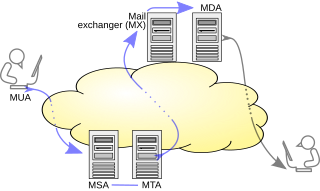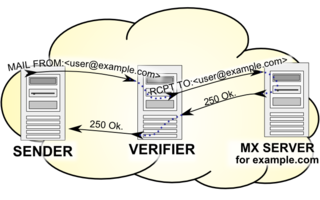
Electronic mail is a method of transmitting and receiving messages using electronic devices. It was conceived in the late–20th century as the digital version of, or counterpart to, mail. Email is a ubiquitous and very widely used communication medium; in current use, an email address is often treated as a basic and necessary part of many processes in business, commerce, government, education, entertainment, and other spheres of daily life in most countries.
Within the Internet email system, a message transfer agent (MTA), mail transfer agent, or mail relay is software that transfers electronic mail messages from one computer to another using the Simple Mail Transfer Protocol. In some contexts, the alternative names mail server, mail exchanger, or MX host are used to describe an MTA.
The Simple Mail Transfer Protocol (SMTP) is an Internet standard communication protocol for electronic mail transmission. Mail servers and other message transfer agents use SMTP to send and receive mail messages. User-level email clients typically use SMTP only for sending messages to a mail server for relaying, and typically submit outgoing email to the mail server on port 587 or 465 per RFC 8314. For retrieving messages, IMAP is standard, but proprietary servers also often implement proprietary protocols, e.g., Exchange ActiveSync.

An email client, email reader or, more formally, message user agent (MUA) or mail user agent is a computer program used to access and manage a user's email.
Various anti-spam techniques are used to prevent email spam.
Sender Policy Framework (SPF) is an email authentication method which ensures the sending mail server is authorized to originate mail from the email sender's domain. This authentication only applies to the email sender listed in the "envelope from" field during the initial SMTP connection. If the email is bounced, a message is sent to this address, and for downstream transmission it typically appears in the "Return-Path" header. To authenticate the email address which is actually visible to recipients on the "From:" line, other technologies such as DMARC must be used. Forgery of this address is known as email spoofing, and is often used in phishing and email spam.
Greylisting is a method of defending e-mail users against spam. A mail transfer agent (MTA) using greylisting will "temporarily reject" any email from a sender it does not recognize. If the mail is legitimate, the originating server will try again after a delay, and if sufficient time has elapsed, the email will be accepted.
In email, a return receipt is an acknowledgment by the recipient's email client to the sender of receipt of an email message. What acknowledgment, if any, is sent by the recipient to the sender is dependent on the email software of the recipient.
Email authentication, or validation, is a collection of techniques aimed at providing verifiable information about the origin of email messages by validating the domain ownership of any message transfer agents (MTA) who participated in transferring and possibly modifying a message.

A message submission agent (MSA), or mail submission agent, is a computer program or software agent that receives electronic mail messages from a mail user agent (MUA) and cooperates with a mail transfer agent (MTA) for delivery of the mail. It uses ESMTP, a variant of the Simple Mail Transfer Protocol (SMTP), as specified in RFC 6409.
The Sender Rewriting Scheme (SRS) is a scheme for bypassing the Sender Policy Framework's (SPF) methods of preventing forged sender addresses. Forging a sender address is also known as email spoofing.
Variable envelope return path (VERP) is a technique used by some electronic mailing list software to enable automatic detection and removal of undeliverable e-mail addresses. It works by using a different return path for each recipient of a message.
Sieve is a programming language that can be used for email filtering. It owes its creation to the CMU Cyrus Project, creators of Cyrus IMAP server.
Emailtracking is a method for monitoring whether the email message is read by the intended recipient. Most tracking technologies use some form of digitally time-stamped record to reveal the exact time and date when an email is received or opened, as well as the IP address of the recipient.
A challenge–response system is a type of that automatically sends a reply with a challenge to the (alleged) sender of an incoming e-mail. It was originally designed in 1997 by Stan Weatherby, and was called Email Verification. In this reply, the purported sender is asked to perform some action to assure delivery of the original message, which would otherwise not be delivered. The action to perform typically takes relatively little effort to do once, but great effort to perform in large numbers. This effectively filters out spammers. Challenge–response systems only need to send challenges to unknown senders. Senders that have previously performed the challenging action, or who have previously been sent e-mail(s) to, would be automatically receive a challenge.

Callback verification, also known as callout verification or Sender Address Verification, is a technique used by SMTP software in order to validate e-mail addresses. The most common target of verification is the sender address from the message envelope. It is mostly used as an anti-spam measure.
Email forwarding generically refers to the operation of re-sending a previously delivered email to an email address to one or more different email addresses.
An email alias is simply a forwarding email address. The term alias expansion is sometimes used to indicate a specific mode of email forwarding, thereby implying a more generic meaning of the term email alias as an address that is forwarded in a simplistic fashion.
Backscatter is incorrectly automated bounce messages sent by mail servers, typically as a side effect of incoming spam.
A bounce address is an email address to which bounce messages are delivered. There are many variants of the name, none of them used universally, including return path, reverse path, envelope from, envelope sender, MAIL FROM, 5321-FROM, return address, From_, Errors-to, etc. It is not uncommon for a single document to use several of these names.




